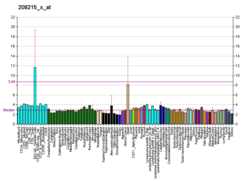The dopamine receptor D4 is a dopamine D2-like G protein-coupled receptor encoded by the DRD4 gene on chromosome 11 at 11p15.5.[5]
The structure of DRD4 has been reported in complex with the antipsychotic drug nemonapride.[6]
As with other dopamine receptor subtypes, the D4 receptor is activated by the neurotransmitter dopamine. It is linked to many neurological and psychiatric conditions[7] including schizophrenia and bipolar disorder,[8] ADHD,[9][10] addictive behaviors,[11] Parkinson's disease,[12] and eating disorders such as anorexia nervosa.[13] A weak association has been drawn between DRD4 and borderline personality disorder.
It is also a target for drugs which treat schizophrenia and Parkinson's disease.[14] The D4 receptor is considered to be D2-like in which the activated receptor inhibits the enzyme adenylate cyclase, thereby reducing the intracellular concentration of the second messenger cyclic AMP.[15]
- ^ a b c ENSG00000276825 GRCh38: Ensembl release 89: ENSG00000069696, ENSG00000276825 – Ensembl, May 2017
- ^ a b c GRCm38: Ensembl release 89: ENSMUSG00000025496 – Ensembl, May 2017
- ^ "Human PubMed Reference:". National Center for Biotechnology Information, U.S. National Library of Medicine.
- ^ "Mouse PubMed Reference:". National Center for Biotechnology Information, U.S. National Library of Medicine.
- ^ Van Tol HH, Bunzow JR, Guan HC, Sunahara RK, Seeman P, Niznik HB, Civelli O (April 1991). "Cloning of the gene for a human dopamine D4 receptor with high affinity for the antipsychotic clozapine". Nature. 350 (6319): 610–4. Bibcode:1991Natur.350..610V. doi:10.1038/350610a0. PMID 1840645. S2CID 4244670.
- ^ Wang S, Wacker D, Levit A, Che T, Betz RM, McCorvy JD, Venkatakrishnan AJ, Huang XP, Dror RO, Shoichet BK, Roth BL (October 2017). "D4 dopamine receptor high-resolution structures enable the discovery of selective agonists". Science. 358 (6361): 381–386. Bibcode:2017Sci...358..381W. doi:10.1126/science.aan5468. PMC 5856174. PMID 29051383.
- ^ Ptácek R, Kuzelová H, Stefano GB (September 2011). "Dopamine D4 receptor gene DRD4 and its association with psychiatric disorders". Medical Science Monitor. 17 (9): RA215–20. doi:10.12659/MSM.881925. PMC 3560519. PMID 21873960.
- ^ Domschke K (July 2013). "Clinical and molecular genetics of psychotic depression". Schizophrenia Bulletin. 39 (4): 766–75. doi:10.1093/schbul/sbt040. PMC 3686457. PMID 23512949.
- ^ LaHoste GJ, Swanson JM, Wigal SB, Glabe C, Wigal T, King N, Kennedy JL (May 1996). "Dopamine D4 receptor gene polymorphism is associated with attention deficit hyperactivity disorder". Molecular Psychiatry. 1 (2): 121–4. PMID 9118321.
- ^ Smalley SL, Bailey JN, Palmer CG, Cantwell DP, McGough JJ, Del'Homme MA, Asarnow JR, Woodward JA, Ramsey C, Nelson SF (September 1998). "Evidence that the dopamine D4 receptor is a susceptibility gene in attention deficit hyperactivity disorder". Molecular Psychiatry. 3 (5): 427–30. doi:10.1038/sj.mp.4000457. PMID 9774776.
- ^ McGeary J (September 2009). "The DRD4 exon 3 VNTR polymorphism and addiction-related phenotypes: a review". Pharmacology Biochemistry and Behavior. 93 (3): 222–9. doi:10.1016/j.pbb.2009.03.010. PMC 2706302. PMID 19336242.
- ^ Cormier F, Muellner J, Corvol JC (April 2013). "Genetics of impulse control disorders in Parkinson's disease". Journal of Neural Transmission. 120 (4): 665–71. doi:10.1007/s00702-012-0934-4. PMID 23232665. S2CID 21967333.
- ^ Rask-Andersen M, Olszewski PK, Levine AS, Schiöth HB (March 2010). "Molecular mechanisms underlying anorexia nervosa: focus on human gene association studies and systems controlling food intake". Brain Research Reviews. 62 (2): 147–64. doi:10.1016/j.brainresrev.2009.10.007. PMID 19931559. S2CID 37635456.
- ^ Ptáček R, Kuželová H, Stefano GB, Raboch J, Kream RM (April 2013). "Targeted D4 dopamine receptors: implications for drug discovery and therapeutic development". Current Drug Targets. 14 (4): 507–12. doi:10.2174/1389450111314040012. PMID 23469923.
- ^ Neve KA, Seamans JK, Trantham-Davidson H (August 2004). "Dopamine receptor signaling". Journal of Receptor and Signal Transduction Research. 24 (3): 165–205. CiteSeerX 10.1.1.465.5011. doi:10.1081/RRS-200029981. PMID 15521361. S2CID 12407397.




